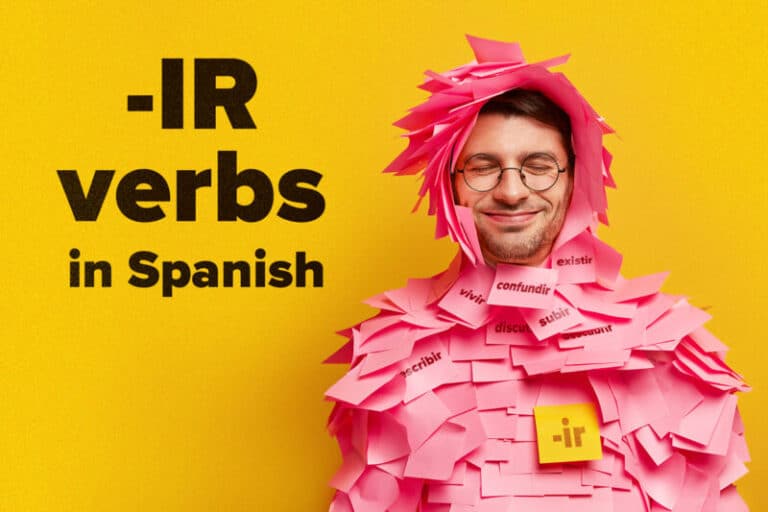Contents
- 1. Tiene pinta de ser
- 2. Más … que nada
- 3. Perder los estribos
- 4. En mi día a día
- 5. Como ningún otro
- 6. Hacer la vista gorda
- 7. Desde luego
- 8. Ganarse la vida
- 9. Por otra parte…
- 10. Dar vueltas a
- 11. Dar gato por liebre
- 12. Poner en marcha
- How to Diversify Your Spanish Vocabulary
- And One More Thing…
Common Advanced Spanish Phrases to Try Out

Now that you have a solid intermediate level of Spanish speaking, it’s time to take your Spanish to the next level with advanced phrases. Focusing on interesting or uncommon vocabulary is a great way to make the leap from intermediate to advanced Spanish.
In this post, we will teach you 12 advanced Spanish phrases which will not only help your comprehension but also make you sound like a native speaker.
Download: This blog post is available as a convenient and portable PDF that you can take anywhere. Click here to get a copy. (Download)
1. Tiene pinta de ser
Meaning: It seems
Common word to replace: Parece
I couldn’t tell you why the word pinta—which means “pint” and “he/she paints”—also means “aspect” or “appearance.” Oh, well—languages are just complicated like that.
You may have heard someone say “tiene buena pinta” (it looks great) to describe food, a good idea or even an attractive person. But the word pinta can actually be used with many adjectives, not just buena or its opposite, mala (bad).
Instead of using the verb parecer (to seem, to appear), try throwing in the phrase tiene pinta de ser plus the adjective of your choice. It has almost the same meaning, and it’ll help you vary your speech and sound more colloquial.
Ese restaurante tiene pinta de ser muy caro.
(That restaurant looks really expensive.)
2. Más … que nada
Meaning: Very
Common word to replace: Muy
Spanish negative words can be tricky for native English speakers to get the hang of. In this case, nada (nothing) functions like the English word “anything.” So, this phrase means “More [adjective] than anything.”
Use this phrase to add emphasis when describing something. Because why say “very good” over and over again, when occasionally you can throw in “This is the best thing ever”?
El chocolate es más rico que nada.
(Chocolate is the most delicious thing in the world.)
3. Perder los estribos
Meaning: Get angry
Common word to replace: Enfadarse, enojarse
Perder los estribos (lose the stirrups) is not a perfect synonym for enfadarse, but it’s a great phrase to describe a specific type of anger.
To perder los estribos means to lose one’s head, get irrationally angry or talk without sense or reason due to anger. The phrase especially refers to short-tempered people or those with little patience who have a tendency to blow their top at the slightest provocation.
El niño no dejaba de gimotear, y al final su madre perdió los estribos.
(The boy wouldn’t stop whining, and finally his mother lost her temper.)
4. En mi día a día
Meaning: Usually
Common word to replace: Normalmente, usualmente
Usualmente (usually) and normalmente (normally) work just fine to express habitual actions. However, for a more colloquial and literary way to express the same concept, try en mi día a día. It’s a great phrase to describe actions that are part of your everyday routine.
Intento comer sano en mi día a día, pero de vez en cuando me apetece una pizza o una hamburguesa.
(I try to eat healthy on a day-to-day basis, but every so often I’m in the mood for a pizza or a hamburger.)
5. Como ningún otro
Meaning: Unique
Common word to replace: Único
“Unique” is one of those interesting words that can be positive, neutral or negative depending on context. For that reason, it’s a very useful word and comes in handy in many different situations.
Instead of único, try using como ningún otro (like nobody/nothing else). Remember that if you’re referring to a female or to a feminine-gendered object, you’ll need to change the phrase to como ninguna otra.
You can use this phrase in two different ways. First, you can use it on its own as a synonym for único.
Ella siempre se viste bien. Tiene un estilo como ninguna otra.
(She’s always well-dressed. She has a completely unique style.)
You can also use como ningún otro with a noun at the end, to say that something is “like no other _____.”
París es increíble. Es como ningún otro lugar en el mundo.
(Paris is incredible. It’s like no other place in the world.)
6. Hacer la vista gorda
Meaning: Ignore
Common word to replace: Ignorar
Ignorar (to ignore) is a nice, useful cognate to have in your vocabulary arsenal. However, in certain situations, you can substitute it for the more exciting and colorful phrase hacer la vista gorda.
So what does it mean to “make the fat look” in Spanish? This phrase refers to consciously ignoring something you’d rather not see, like the English “to turn a blind eye” or “to look the other way.”
Because it has such a specific meaning, hacer la vista gorda can’t be directly substituted for ignorar in all contexts, but you can use it to convey a more nuanced meaning to readers or listeners in certain situations.
La profesora sabía que sus estudiantes habían copiado durante el examen, pero hizo la vista gorda.
(The professor knew that her students had copied off of each other during the exam, but she looked the other way.)
7. Desde luego
Meaning: Of course
Common word to replace: Claro, por supuesto
The words claro and por supuesto are highly useful in colloquial Spanish—you can use them to express agreement, excitement or even indignation, depending on the context.
Personally, I find myself completely overusing the word claro, so it’s nice to have a substitute to use every so often! That’s where desde luego comes in.
Literally translated as “since then,” this phrase is a great stand-in for claro. You can also say desde luego que sí (of course), which means more or less the same thing as desde luego. To express the opposite—“of course not”—use desde luego que no.
A: ¿Vas a venir a mi fiesta de cumpleaños?
B: Hombre, ¡desde luego que sí! ¡Nos vemos allí!
(A: Are you going to come to my birthday party?
B: Dude, of course I will! I’ll see you there!)
8. Ganarse la vida
Meaning: Work
Common word to replace: Trabajar
In Spanish, ganarse la vida (literal translation: earn yourself the life) is roughly equivalent to the English phrases “to earn a living” or “to make a living.”
As in English, you can use the phrase to specifically talk about the money you make from your work. However, you can also use it in many cases as a substitute for the word trabajar (to work).
It’s a more playful and figurative way to talk about your job, and it sounds more interesting than just saying yo trabajo all the time. Think of it as similar to the English phrase “I do _____ for a living.”
Grammatically, you can use the phrase in two different ways.
First, you can use ganarse la vida + [gerund].
Me gano la vida escribiendo poesía.
(I make a living writing poetry.)
Second, you can use ganarse la vida + como + [a profession].
Me gano la vida como poeta.
(I make my living as a poet.)
9. Por otra parte…
Meaning: Not to mention…
Common word to replace: Además…
Por otra parte is a somewhat confusing phrase because it has two seemingly contradictory meanings.
First, it can be used to introduce further information on a topic or supporting details, such as the English “not to mention…” or “furthermore…”
Me encanta Grecia. La comida allí es estupenda. Por otra parte, la arquitectura es bellísima.
(I love Greece. The food there is stupendous. Furthermore, the architecture is beautiful.)
But por otra parte can also be used to introduce conflicting or contradictory information, like the English “On the other hand…”
No me gusta Nueva York porque me agobia. Pero por otra parte, también es una ciudad con mucha cultura.
(I don’t like New York because it’s overwhelming. But on the other hand, it’s also a city with a lot of culture.)
10. Dar vueltas a
Meaning: Think over
Common word to replace: Pensar
The phrase dar la vuelta can mean to make a turn, either literally or figurative. And when you dar vueltas a something, it means that you’re going over it endlessly in your mind.
As with many other examples in this post, dar vueltas a is not an exact synonym of pensar, and you cannot substitute the two phrases in any context. Use dar vueltas a to specifically talk about something that’s really been troubling you, that you keep going back and forth on in your mind. When used correctly, this turn of phrase can really add a figurative, almost poetic touch to your speech.
Hemos pasado mucho tiempo dando vueltas a la idea, deberíamos tomar una decisión ya.
(We’ve spent a lot of time thinking the idea over, we should make a decision already.)
11. Dar gato por liebre
Meaning: Trick
Common word to replace: Engañar
The Spanish phrase dar gato por liebre (literally: to give a cat for a hare) means to trick someone, and specifically to pass off a poor item or service for something of higher quality. Supposedly, it originates from an old custom of butchers giving unsuspecting customers cat meat instead of hare meat to save money. Gross!
Some English equivalents are “to pull the wool over your eyes,” “to pull a fast one” or “to swindle.”
Esa tienda tiene muy mala fama. Ten cuidado que no te den gato por liebre!
That store has a really bad reputation. Be careful that they don’t pull a fast one on you!
12. Poner en marcha
Meaning: Begin
Common word to replace: Empezar, comenzar
When talking about something beginning, you’ll usually use the word empezar or comenzar. However, in some cases you can use the more interesting phrase poner en marcha, which is similar to the English “put into action.”
Grammatically, you can use this phrase in two ways:
poner en marcha + [noun].
Hoy voy a poner en marcha el proyecto.
(Today I’m going to begin the project.)
poner + [noun] + en marcha.
Hoy voy a poner el proyecto en marcha.
(Today I’m going to begin the project.)
How to Diversify Your Spanish Vocabulary
In order to make the jump from being an intermediate to an advanced Spanish speaker, you must develop a wide and varied vocabulary.
Knowing how to say things not only one way but two or three different ways at least, will help you converse like a native speaker and—just as importantly—understand other native speakers when they communicate with you! Here are some tactics to actively work on improving your vocabulary.
Set aside a time each day to write or think in Spanish
One of the biggest benefits of learning by immersion is that you’re forced to learn the vocabulary to navigate tons of different everyday situations in Spanish. But if you can’t learn by immersion due to lack of time, funds or desire, you can replicate this experience by setting aside time to write or think in Spanish every day.
Either give yourself a topic or simply start writing/internal-monologuing and see where you go. During this time, if you hit a word or phrase that you don’t know how to express in Spanish, make a note of it.
At the end of your time, look up these problem words and write down their correct translations. This stream-of-consciousness writing or thinking exercise will help you identify the gaps in your vocabulary.
Look back at old things you’ve written in Spanish.
Looking at things you wrote in the past can be a great way to measure your progress! For this exercise, though, your previous Spanish writings have a different use. Look back at the text, and challenge yourself to write a new text—one that has the same meaning but uses different, more interesting vocabulary words and phrases.
This will force you to learn synonyms for common words and get out of the pattern of using the same words over and over again. In a few months, you might even pull out your rewritten text and try to rewrite it again!
Consume native Spanish content
Another great way to diversify your Spanish is to consume authentic media so you can see how the language is used by native speakers. There are many ways you can do this, such as by watching content in Spanish on YouTube, listening to Spanish music or trying a language immersion program like FluentU.
FluentU takes authentic videos—like music videos, movie trailers, news and inspiring talks—and turns them into personalized language learning lessons.
You can try FluentU for free for 2 weeks. Check out the website or download the iOS app or Android app.
P.S. Click here to take advantage of our current sale! (Expires at the end of this month)

By seeing native speakers converse, you’ll be able to pick up advanced vocabulary and start using it in your own conversations!
Seek out interesting vocabulary online
Many websites offer a “word of the day” service—some examples are SpanishDict and DonQuijote. For advanced-level practice, try to use each word of the day in your allocated writing/speaking time for that day. You never know where it might take your thoughts or your writing!
Learning fun and interesting vocabulary will ensure that the new words stick in your head—all you have to do is make sure to use them every once in a while to reinforce your knowledge!
These words are a good starting point, but they’re just the tip of the iceberg when it comes to learning advanced Spanish phrases.
Making the jump from being an intermediate to an advanced speaker can require a real investment of time, but it’s worth it to be able to converse in Spanish on a near-native level.
Keep seeking out new Spanish vocabulary—it can be one of the most enjoyable parts of language learning!
Download: This blog post is available as a convenient and portable PDF that you can take anywhere. Click here to get a copy. (Download)
And One More Thing…
If you've made it this far that means you probably enjoy learning Spanish with engaging material and will then love FluentU.
Other sites use scripted content. FluentU uses a natural approach that helps you ease into the Spanish language and culture over time. You’ll learn Spanish as it’s actually spoken by real people.
FluentU has a wide variety of videos, as you can see here:

FluentU brings native videos within reach with interactive transcripts. You can tap on any word to look it up instantly. Every definition has examples that have been written to help you understand how the word is used. If you see an interesting word you don’t know, you can add it to a vocab list.

Review a complete interactive transcript under the Dialogue tab, and find words and phrases listed under Vocab.

Learn all the vocabulary in any video with FluentU’s robust learning engine. Swipe left or right to see more examples of the word you’re on.

The best part is that FluentU keeps track of the vocabulary that you’re learning, and gives you extra practice with difficult words. It'll even remind you when it’s time to review what you’ve learned. Every learner has a truly personalized experience, even if they’re learning with the same video.
Start using the FluentU website on your computer or tablet or, better yet, download the FluentU app from the iTunes or Google Play store. Click here to take advantage of our current sale! (Expires at the end of this month.)







